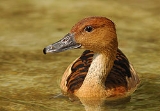
Fulvous Whistling Duck
Encyclopedia
The Fulvous Whistling Duck, Dendrocygna bicolor, is a whistling duck which breeds across the world's tropical regions in much of Central
and South America
, Sub-Saharan Africa
, the Indian subcontinent
, and the Gulf Coast of the United States
.
The Fulvous Whistling Duck is a common but wary species. It is largely resident, apart from local movements, but vagrancy has occurred to southern Europe. It nests on a stick platform in reeds, laying 8–12 eggs, but hollow trees or old bird nests are occasionally used for nesting.
 Its habitat is freshwater lakes, paddy field
Its habitat is freshwater lakes, paddy field
s or reservoir
s with plentiful vegetation, where this duck
feeds mainly at night on seeds and other parts of plants..
The Fulvous Whistling Duck is 48–53 cm (18.9–20.9 in) long. It has a long grey bill, long head and longish legs, buff head and underparts, the latter reddish-tinged on the flanks, a dark crown, and dark grey back and wings. The tail and wing patches are chestnut, and there is a white crescent on the upper tail which is visible in flight.
All plumages are similar, except that juveniles have less contrasted flank and tail colouration.
This species is gregarious, and at favoured sites substantial flocks can form. As the name implies, these are noisy bird
s with a clear whistling kee-wee-ooo call.
The Fulvous Whistling Duck is one of the species to which the Agreement on the Conservation of African-Eurasian Migratory Waterbirds (AEWA
) applies.
Central America
Central America is the central geographic region of the Americas. It is the southernmost, isthmian portion of the North American continent, which connects with South America on the southeast. When considered part of the unified continental model, it is considered a subcontinent...
and South America
South America
South America is a continent situated in the Western Hemisphere, mostly in the Southern Hemisphere, with a relatively small portion in the Northern Hemisphere. The continent is also considered a subcontinent of the Americas. It is bordered on the west by the Pacific Ocean and on the north and east...
, Sub-Saharan Africa
Sub-Saharan Africa
Sub-Saharan Africa as a geographical term refers to the area of the African continent which lies south of the Sahara. A political definition of Sub-Saharan Africa, instead, covers all African countries which are fully or partially located south of the Sahara...
, the Indian subcontinent
Indian subcontinent
The Indian subcontinent, also Indian Subcontinent, Indo-Pak Subcontinent or South Asian Subcontinent is a region of the Asian continent on the Indian tectonic plate from the Hindu Kush or Hindu Koh, Himalayas and including the Kuen Lun and Karakoram ranges, forming a land mass which extends...
, and the Gulf Coast of the United States
Gulf Coast of the United States
The Gulf Coast of the United States, sometimes referred to as the Gulf South, South Coast, or 3rd Coast, comprises the coasts of American states that are on the Gulf of Mexico, which includes Texas, Louisiana, Mississippi, Alabama, and Florida and are known as the Gulf States...
.
The Fulvous Whistling Duck is a common but wary species. It is largely resident, apart from local movements, but vagrancy has occurred to southern Europe. It nests on a stick platform in reeds, laying 8–12 eggs, but hollow trees or old bird nests are occasionally used for nesting.

Paddy field
A paddy field is a flooded parcel of arable land used for growing rice and other semiaquatic crops. Paddy fields are a typical feature of rice farming in east, south and southeast Asia. Paddies can be built into steep hillsides as terraces and adjacent to depressed or steeply sloped features such...
s or reservoir
Reservoir
A reservoir , artificial lake or dam is used to store water.Reservoirs may be created in river valleys by the construction of a dam or may be built by excavation in the ground or by conventional construction techniques such as brickwork or cast concrete.The term reservoir may also be used to...
s with plentiful vegetation, where this duck
Duck
Duck is the common name for a large number of species in the Anatidae family of birds, which also includes swans and geese. The ducks are divided among several subfamilies in the Anatidae family; they do not represent a monophyletic group but a form taxon, since swans and geese are not considered...
feeds mainly at night on seeds and other parts of plants..
The Fulvous Whistling Duck is 48–53 cm (18.9–20.9 in) long. It has a long grey bill, long head and longish legs, buff head and underparts, the latter reddish-tinged on the flanks, a dark crown, and dark grey back and wings. The tail and wing patches are chestnut, and there is a white crescent on the upper tail which is visible in flight.
All plumages are similar, except that juveniles have less contrasted flank and tail colouration.
This species is gregarious, and at favoured sites substantial flocks can form. As the name implies, these are noisy bird
Bird
Birds are feathered, winged, bipedal, endothermic , egg-laying, vertebrate animals. Around 10,000 living species and 188 families makes them the most speciose class of tetrapod vertebrates. They inhabit ecosystems across the globe, from the Arctic to the Antarctic. Extant birds range in size from...
s with a clear whistling kee-wee-ooo call.
The Fulvous Whistling Duck is one of the species to which the Agreement on the Conservation of African-Eurasian Migratory Waterbirds (AEWA
AEWA
The Agreement on the Conservation of African-Eurasian Migratory Waterbirds is the largest of its kind developed so far under the Bonn Convention. It was concluded on 16 June 1995 at The Hague, the Netherlands and entered into force on 1 November 1999 after the required number of at least fourteen...
) applies.
External links
- Fulvous Whistling Duck at USGS
- Fulvous Whistling-duck videos at the Internet Bird Collection

